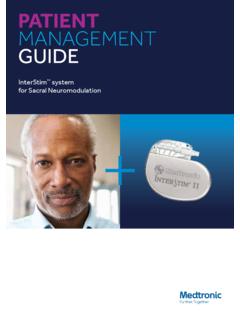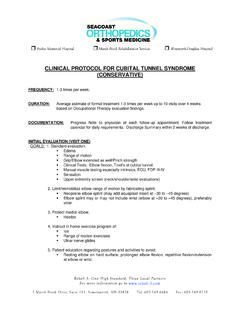Transcription of THE MANAGEMENT OF TUBAL PREGNANCY - …
1 THE MANAGEMENT OF TUBAL PREGNANCYThis guideline replaces The MANAGEMENT of TUBAL pregnancies, produced in October and scopeThere were 13 maternal deaths resulting from ectopic PREGNANCY in the UK during the period 1997 incidence of ectopic PREGNANCY has remained static in recent years ( pregnancies) and nearly32000 ectopic pregnancies are diagnosed in the UK within a three year PREGNANCY can be managed by laparotomy, operative laparoscopy, medically and occasionally byobservation alone. MANAGEMENT must be tailored to the clinical condition and future fertility requirements ofthe concern raised in the Confidential Enquiry into Maternal Deaths was the difficulty encountered indiagnosing ectopic remit of this guideline is not to discuss the methods available for thediagnosis of ectopic PREGNANCY but to discuss the methods and techniques that may be used once a diagnosishas been made.
2 However, it is acknowledged that, when discussing the expectant and medical managementof TUBAL PREGNANCY , in some women the site of PREGNANCY implantation will be and assessment of evidencePrevious guidelines within this subject area were sought using the sites and gateways laid out in the RCOG clinical governance advice document Searching for Cochrane Library (including theDatabase of Systematic Reviews, DARE and the trials registry) and Medline were searched using acombination of MeSH terms and keywords used were ectopic PREGNANCY , TUBAL PREGNANCY , laparoscopy , laparoscopic , salpingectomy , salpingotomy , methotrexate , persistent trophoblast and betahuman chorionic gonadotrophin ( hCG).
3 Reference lists of the articles identified were hand searched foradditional articles, and some experts within the field were levels of evidence and the grades of recommendations used in this guideline for effectiveness originatefrom the US Agency for Healthcare Research and possible, recommendations are based on, andexplicitly linked to, the evidence that supports them. Areas lacking evidence are highlighted and annotatedas good practice points .1 of 10 RCOG Guideline No. 21 Guideline No. 21 May MANAGEMENT of TUBAL pregnancyA laparoscopic approach to the surgical MANAGEMENT of TUBAL PREGNANCY , in the haemodynamicallystable patient, is preferable to an open surgery has been compared with open surgery in 228 women in three randomisedcontrolled trials (RCTs).
4 Laparoscopic procedures were associated with shorter operation times,less intraoperative blood loss, shorter hospital stays and lower analgesic 7 There wasno difference in overall TUBAL patency rates (RR , 95% CI ) between the twoapproaches. In women who desired future fertility (n= 145), the subsequent intrauterinepregnancy rates were similar (RR , 95% CI ) and there was a trend toward lower repeatectopic PREGNANCY rates if a laparoscopic approach was used (RR , 95% CI ). However,laparoscopic salpingotomy was less successful than an open approach in elimination of the tubalpregnancy (RR , 95% CI ), reflected in a trend towards higher rates of persistenttrophoblast (RR , 95% CI ).
5 It is important to note that these three trials only include 228 women, which is insufficient to lookat small differences between the two interventions with respect to many of the of TUBAL PREGNANCY in the presence of haemodynamic instability should be by the mostexpedient method. In most cases this will be is no role for medical MANAGEMENT in the treatment of TUBAL PREGNANCY or suspected tubalpregnancy when a patient shows signs of hypovolaemic ultrasonography canrapidly confirm the presence of haemoperitoneum if there is any diagnostic uncertainty8butexpedient resuscitation and surgery should be undertaken.
6 Experienced operators may be able tomanage laparoscopically women with even a large haemoperitoneum safely9but the surgicalprocedure which prevents further blood loss most quickly should be used. In most centres this willbe the presence of a healthy contralateral tube there is no clear evidence that salpingotomy should beused in preference to number of systematic reviews have examined reproductive outcomes following the managementof TUBAL PREGNANCY with either salpingotomy or salpingectomy. However, there are no RCTs thatspecifically compare laparoscopic (or open) salpingectomy and salpingotomy.
7 The reviewspublished on this subject include data from observational studies, often a mixture of both cohortstudies and case series, as well as a mixture of open and laparoscopic reviewsshow that there is not an increased chance of subsequent intrauterine PREGNANCY aftersalpingotomy compared with salpingectomy. However, these data must be interpreted withcaution. Included studies are subject to a wide range of biases relating to patient selection, surgicalprocedures used, length of follow-up and the proportion of patients lost to 16 There are four recent cohort studies that specifically compare laparoscopic conservative andradical treatments of ectopic pregnancy17 20 Silva et reproductive outcomesprospectively in 143 women undergoing laparoscopic salpingectomy ( ) or laparoscopicsalpingotomy ( ).
8 The intrauterine PREGNANCY rates were similar when comparing the twogroups but there was a trend towards higher subsequent ectopic PREGNANCY in the salpingotomyarm (intrauterine PREGNANCY 60% versus 54%, RR , 95% CI ; recurrent ectopicpregnancy 18% versus 8%, RR , 95% CI ).17 RCOG Guideline No. 212of 10 AEvidencelevel IaCEvidencelevel IVEvidencelevel IIaBJob-Spira et al.,18in a study of 155 women, performed a multivariate analysis on reproductiveoutcomes following ectopic PREGNANCY . They demonstrated a trend towards improved subsequentintrauterine PREGNANCY rates with conservative surgery (hazard ratio , 95% CI ).
9 Thecumulative PREGNANCY rates at one year were after conservative and after radical study by Mol et a cohort of 135 women, the fecundity rate ratio (FRR) when comparinglaparoscopic salpingotomy to salpingectomy during the 18-month follow-up period was (95%CI ) for women with a healthy contralateral tube and (95% CI ) for womenwith contralateral TUBAL disease. The three-year cumulative PREGNANCY rate was 62% aftersalpingotomy and 38% after a study by Bangsgaard et a cohort of 276 women undergoing salpingotomy orsalpingectomy, the subsequent cumulative PREGNANCY rate at seven years was 89% followingsalpingotomy and 66% following salpingectomy (log rank P< ).
10 The hazard ratio for intrauterinepregnancy following salpingectomy was (95% CI ) when compared results suggest that there may be a higher subsequent intrauterine PREGNANCY rate associatedwith salpingotomy but the magnitude of this benefit may be small. Data from future RCTsexamining this question are use of conservative surgical techniques exposes womento a small risk of TUBAL bleeding in the immediate postoperative period and the potential need forfurther treatment for persistent trophoblast. Both these risks and the possibility of further ectopicpregnancies in the conserved tube should be discussed if salpingotomy is being considered by thesurgeon or requested by the salpingotomy should be considered as the primary treatment when managing tubalpregnancy in the presence of contralateral TUBAL disease and the desire for future cohort studies have examined reproductive outcomes in women with contralateral tubaldisease and show a trend toward a greater subsequent intrauterine PREGNANCY






